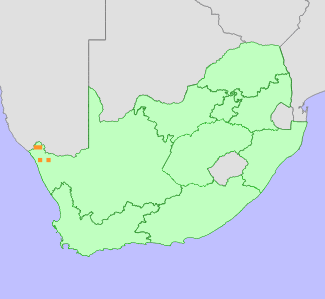|
Scientific Name | Acanthopsis tuba H.M.Steyn |
Higher Classification | Dicotyledons |
Family | ACANTHACEAE |
Synonyms | Acanthopsis carduifolia in the sense of Williamson (2000), not of (L.f.) Schinz (misapplied name) |
National Status |
Status and Criteria | Endangered B1ab(iii) |
Assessment Date | 2022/09/09 |
Assessor(s) | L. von Staden, H.M. Steyn & P.C.V. Van Wyk |
Justification | An endemic species with an extent of occurrence (EOO) of 389 km², it is known from fewer than five locations where there is a continued decline in the quality of habitat due to past severe overgrazing and ongoing mortality of surrounding vegetation from drought. This species is therefore listed as Endangered under criterion B. |
Distribution |
Endemism | South African endemic |
Provincial distribution | Northern Cape |
Range | This Northern Cape endemic has a restricted distribution and occurs in the Richtersveld, from Helskloof to Anenous. |
Habitat and Ecology |
Major system | Terrestrial |
Major habitats | Anenous Plateau Shrubland, Central Richtersveld Mountain Shrubland |
Description | It is found on well-drained clay-loam soils on rocky hill slopes or plains, growing in shrubland. |
Threats |
| It was threatened by overgrazing between 2002 and 2015 at all known locations. At one location, known through historical records, it cannot be relocated as the habitat has been severely degraded from livestock grazing and is possibly already locally extinct. Due to recent droughts (2015-2022), livestock numbers dropped drastically, and overgrazing is less of a problem but may increase in the future should rain suffice. The effect of the drought on this species is unknown, but it is causing general habitat degradation across the Richtersveld. |
Population |
This species is apparently rare, as it is known from only five collections from widely scattered locations. Several searches have relocated this species at only three locations, while two historical collection localities are severely overgrazed, and the species cannot be relocated in these areas and may already be locally extinct. The population is declining due to habitat degradation as a result of overgrazing.
|
Population trend | Decreasing |
Assessment History |
Taxon assessed |
Status and Criteria |
Citation/Red List version | | Acanthopsis tuba H.M.Steyn | EN B1ab(iii,v) | 2017.1 | | Acanthopsis sp. (Marloth 12222 PRE) | EN B1ab(iii,v) | 2015.1 | |
Bibliography |
Steyn, H.M. and Van Wyk, A.E. 2015. Taxonomic notes on the Acanthopsis disperma-hoffmannseggiana complex (Acanthaceae, tribe Acantheae), with an interim key to members of the genus. Phytotaxa 219(1):1-26.
Williamson, G. 2000. Richtersveld, the enchanted wilderness. Umdaus Press, Pretoria.
|
Citation |
| von Staden, L., Steyn, H.M. & Van Wyk, P.C.V. 2022. Acanthopsis tuba H.M.Steyn. National Assessment: Red List of South African Plants version . Accessed on 2025/04/14 |
 Comment on this assessment
Comment on this assessment

